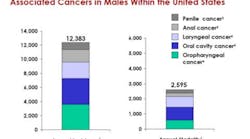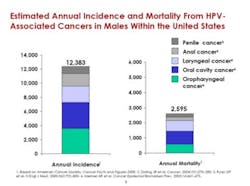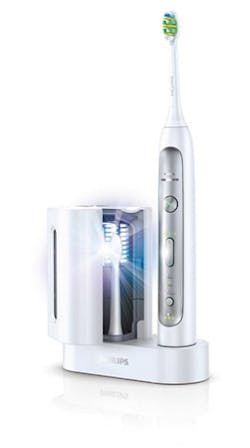We continue our journey to understand HPV-related oropharygeal cancer. Risk factors for HPV-positive oropharyngeal cancer are: a high number of sexual partners (25% increase >= 6 partners); history of oral-genital sex (125% >= 4 partners); history of anal–oral sex; a female partner had a history of either an abnormal Pap smear or a cervical dysplasia; chronic periodontitis; and among men, decreasing age at first intercourse and history of genital warts.(1,2,3)
As well, the Centers For Disease Control and Prevention (CDC) and the American Academy of Pediatrics recommend both boys and girls get the HPV vaccine between the ages of 11 and 12.(6) Doctors say the vaccine is most effective if administered before a child becomes sexually active. Hence the controversy, children having sexual relations! Some argue that if given the vaccine, the children would then be more likely to have sexual relations, much like the arguments against birth control. HPV vaccination in the recommended ages was not associated with increased sexual activity–related outcome rates.(7)
HPV-Associated Oropharyngeal Cancer Rates by Race, Ethnicity, and Sex, United States, 2004–2008
This graph was adapted from Centers for Disease Control and Prevention (CDC). Human papillomavirus–associated cancers—United States, 2004–2008. MMWR 2012;61(15):258–261.
A blood test for oral cancers caused by HPV may be on horizon. The antibodies for HPV-related oral cancer are there more than a decade before the cancer was clinically detectable. More than 60 percent of oropharyngeal cancers were caused by HPV, particularly the HPV16 strain.(8)
In the meantime, we should continue to use our head and neck exams and new technology to detect cancer at an early stage. We can increase public awareness and education of prevention and risk factors, and provide tools to our patients and communities. Treatment will improve, as the power of nanotechnology to engineer devices to analyze human fluids and tissues for abnormal molecules that are indicative of a developing oral tumor are developed. In-office diagnostic devices to detect abnormal cells and proteins in saliva that are associated with a developing oral tumor continue to evolve.
To view a PDF of Detecting Oral Cancer, A Guide for Health Care Professionals, click here.
In the future, we will likely see treatment decisions for the individual patient on the basis of tumor HPV status, targeted molecular therapy and personalized medicine. We have learned more in the past 10 years than we had learned in the previous 2000 years.(9) Of the Twenty Top Predictions For Life 100 Years From Now (BBC-UK), much like those in 1900, one stands out. According to one futurist, thanks to DNA and robotic engineering, we will have created incredibly intelligent humans who are immortal (game_over), with a likelihood 9/10. Another futurist agrees, and says there is a good chance of this happening.
The idea that breakthroughs in the field of genetics, biotechnology and artificial intelligence will expand human intelligence and allow our species to essentially defeat death is sometimes called the Singularity. Can you even imagine immortality? Kurzweil writes that, due to paradigm shifts, a trend of exponential growth extends Moore's law to integrated circuits from earlier transistors, vacuum tubes, relays, and electromechanical computers.(10) He predicts that the exponential growth will continue, and that in a few decades the computing power of all computers will exceed that of human brains, with superhuman artificial intelligence appearing around the same time.
The future I bright! Thanks to Philips Sonicare for its educational grant for this course.












